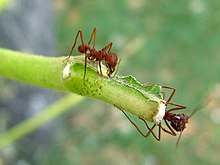| Texas leafcutter ant | |
|---|---|

| |
| Harvesting from a catalpa tree | |
| Scientific classification | |
| Domain: | Eukaryota |
| Kingdom: | Animalia |
| Phylum: | Arthropoda |
| Class: | Insecta |
| Order: | Hymenoptera |
| Family: | Formicidae |
| Subfamily: | Myrmicinae |
| Genus: | Atta |
| Species: | A. texana |
| Binomial name | |
| Atta texana Buckley, 1860 | |
The Texas leafcutter ant (Atta texana) is a species of fungus-farming ant in the subfamily Myrmicinae. It is found in Texas, Louisiana, and north-eastern Mexico. Other common names include town ant, parasol ant, fungus ant, cut ant, and night ant. It harvests leaves from over 200 plant species, and is considered a major pest of agricultural and ornamental plants, as it can defoliate a citrus tree in less than 24 hours. Every colony has several queens and up to 2 million workers. Nests are built in well-drained, sandy or loamy soil, and may reach a depth of 6 m (20 ft), have 1000 entrance holes, and occupy 420 m (4,500 sq ft).
Description
Workers measure 4 to 14 mm (0.16 to 0.55 in) in length, and are highly polymorphic. The back of the thorax has three pairs of spines. The ant has a narrow waist and is rusty brown in color. It should also be mentioned: Its closely related cousin, Atta mexicana has colonies up to 8 Million, and the queen for A. mexicana is larger than the texana queen; however, it should also be mentioned that A. mexicana is only able to have a single queen, while A. texana may have multiple queens (Often 2). This makes the species polygyne and because of this trait, A. texana can form massive super colonies with upwards of 10,000,000 total ants in the colony. Because of the massive super colonies that they can form, they have been known to cause issues in the local environment and have been a troubling pest for humans living nearby these super colonies.
Life Cycle
The queen ant will deposit eggs that then hatch into cream colored larvae. Fully developed 1/4 to ½ inch long larvae form pupae. In the spring, some larvae develop into larger (3/4 inch long) winged male and female ants, called reproductives. Males have much smaller heads than do females and both have long smoky black wings.
Behavior
The nuptial flights of A. texana synchronize in regions; the virgin queens and males fly at night. Their foraging type is Mass Recruitment (MR). The Mass Recruitment foraging type consists of many ants all going out into one big group and searching for food.
References
- ^ Robinson, William H. (2005). Handbook of Urban Insects and Arachnids. Cambridge University Press. pp. 238–239. ISBN 978-0-521-81253-5.
- "Texas Leaf Cutting Ant". Insects in the City. Texas AgriLife Extension. 2006-08-30. Archived from the original on October 15, 2008. Retrieved 2010-01-04.
- Beckers, R; Goss, S; DENEUBOURG, J.L.; PASTEELS, J.M. "COLONY SIZE, COMMUNICATION AND ANT FORAGING STRATEGY*" (PDF). Antwiki.org. University Libre de Bruxelles. Retrieved 10 August 2023.
- Walter, E.V.; Seaton, Lee; Mathewson, A.A. "The Texas leaf-cutting ant and its control". Hathitrust.org. university of illinois urbana champaign. Retrieved 10 August 2023.
- Hölldobler, Bert; Holldobler, Foundation Professor of Biology Bert; Wilson, Honorary Curator in Entomology and University Research Professor Emeritus Edward O.; Wilson, Edward O. (2009). The Superorganism: The Beauty, Elegance, and Strangeness of Insect Societies. W. W. Norton & Company. ISBN 9780393067040.
- Beckers, R; Goss, S; DENEUBOURG, J.L.; PASTEELS, J.M. "COLONY SIZE, COMMUNICATION AND ANT FORAGING STRATEGY*" (PDF). Antwiki.org. University Libre de Bruxelles. Retrieved 10 August 2023.
- Reznikova, Zhanna. "Ants' Personality and Its Dependence on Foraging Styles: Research Perspectives". Researchgate.net. Institute of Systematics and Ecology of Animals. Retrieved 10 August 2023.
- Evans, Arthur V (2007). "Ants, Bees, and Wasps: Order Hymenoptera". National Wildlife Federation Field Guide to Insects and Spiders & Related Species of North America. Sterling Publishing Co., Inc. p. 380. ISBN 978-1-4027-4153-1.
External links
- "Texas Leaf Cutting Ant". Insects in the City. 2019-03-21. Retrieved 2021-07-19.
- "Texas Leaf Cutting Ant, Atta texana". Urban and Structural Entomology Program at Texas A&M University. 2013-12-05. Retrieved 2022-01-19.
| Taxon identifiers | |
|---|---|
| Atta texana | |
This Myrmicinae-related article is a stub. You can help Misplaced Pages by expanding it. |